Anyone reading my blog is likely familiar with my selection of topics based on the latest rabbit hole to attract my attention and elicit a leap on my part, a derailment of sorts.
Supplements to the manual were published when the model first became available. Duet often offered very valuable tables, ie an electronic pattern matching chars in #6, pp 21 and 22
I still own an E6000, but it has been used infrequently in the past few years.
When my iMac was replaced with a new one with an M1 chip I purchased a PC to use for knitting downloads that were not possible on the Mac.
At present, I am working on establishing downloading to the Passap from the PC using Wincrea, the Croucher cable, and a USB to a serial connector, and am considering exploring some knits in the spirit of how and why the stitch formations happen, still comparing the results to those using Brother knitting machines.
At one point, I taught advanced knitting workshops to textile students and immersed myself in gathering pertinent information before doing so.
Every one of my Passap manual pages is pretty much marked in a manner such as this. At the time, the added notes made perfect sense.
A couple of decades later, my scribbles require deciphering, and I find myself wishing for what might have been an expanded notebook with notes that would make better sense now.
A place to start: the 2-color double bed techniques, mad hatter scrawls version: 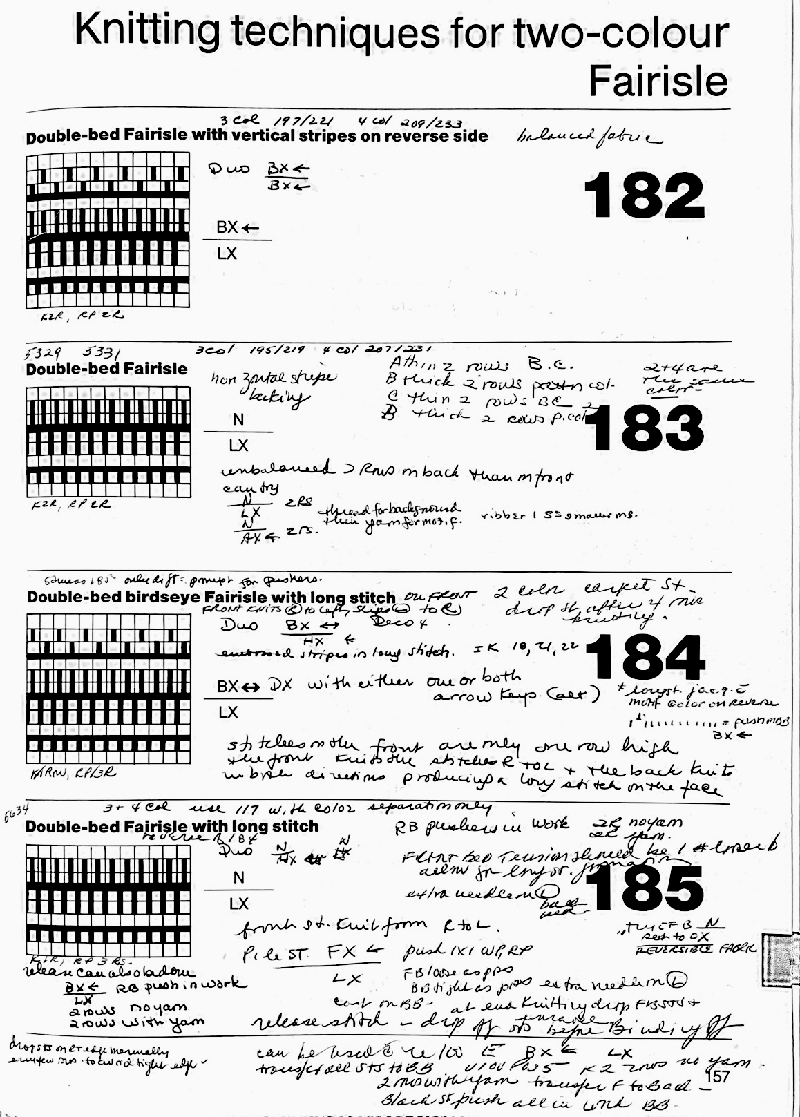
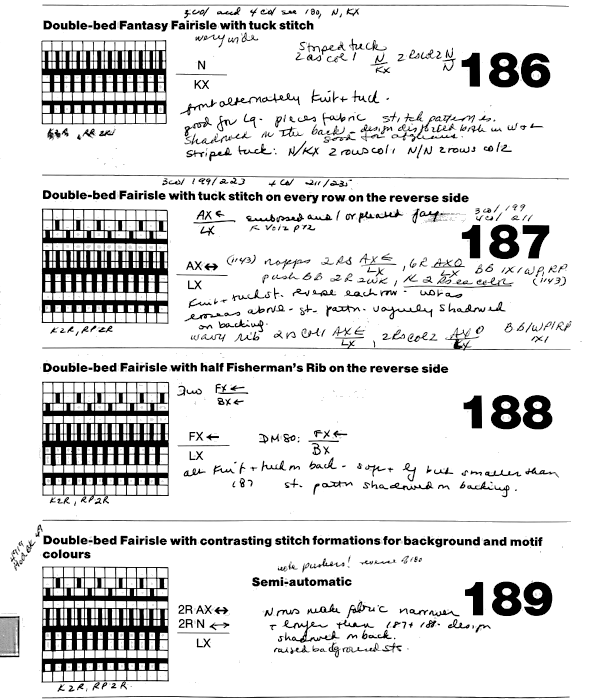



A far more organized source of information: http://www.needlesofsteel.org.uk/downloads/Passap%20DBJ%20Techniques.pdf?
A sample segment from its first page 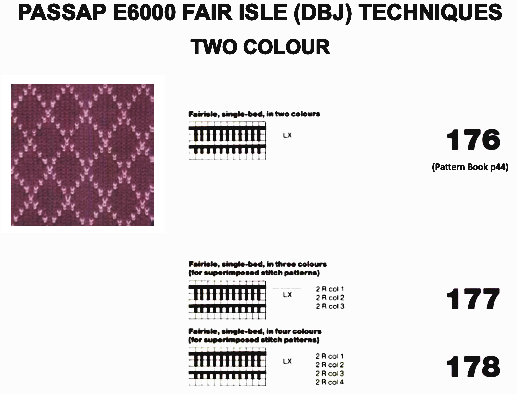 A brief summary of 2-color DBJ techniques that can be executed with no changes to the back lock stitch dial settings on either model.
A brief summary of 2-color DBJ techniques that can be executed with no changes to the back lock stitch dial settings on either model.
Downloading full manuals for E6 or Duo will provide full-scale images of techniques and settings.
180: standard birdseye
181: FI with background color only on the reverse side
182: striper backing, Duo AC but pushers one up, one down on the back bed
183: Duo AX <– or N, but the front lock on BX <-
184: birdseye FI with long stitch
185: FI with long stitch/ half Milano, for drop stitch cast on BB
186: fantasy FI stiped tuck stitch
187: FI with alternating tuck stitch on every row on the purl side
187: AE set up for release stitch, drop stitches on the front bed
188: half fisherman rib on the purl side
191: two rows of alternating tuck on the purl side
set back lock to AX with left arrow key, can try DX<–
It is easy to accumulate pattern books from brands other than the machine brands in our stash.
Arahpaint’s guess weave from grid makes converting published repeats to pngs quick and very often with little or no cleanup. From the Deco pattern book, 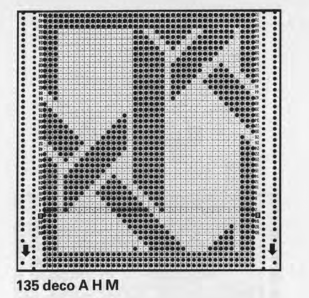 trimmed to 400X400
trimmed to 400X400 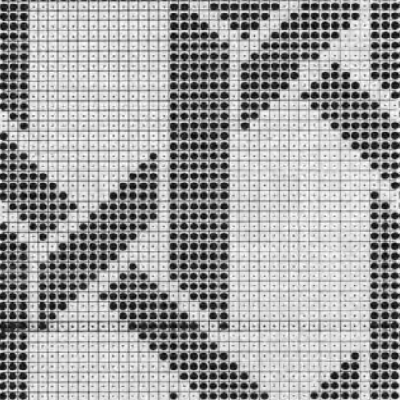 cleaner results were obtained using the color inverted image, in turn cropped to selection,
cleaner results were obtained using the color inverted image, in turn cropped to selection, 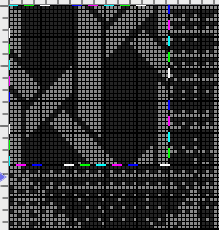
![]() color inverted again, drawn in repeat to identify any missing pixels (red)
color inverted again, drawn in repeat to identify any missing pixels (red) 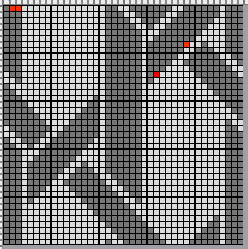 palette to B/W
palette to B/W ![]() the design drawn in repeat again to check alignments
the design drawn in repeat again to check alignments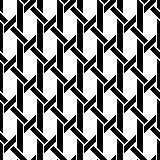 Some Passap designs as ready to knit pngs may be found in this download from Knitstudium
Some Passap designs as ready to knit pngs may be found in this download from Knitstudium
References to Passap machines in my blog post so far:
Passap Duomatic and Deco pattern musings
Two color dbj, non-repetitive images, electronic km for when using designs copied directly from patterns published for use on Japanese knitting machine models
Ribber pitch, a bit on racking 1: chevrons/ horizontal herringbone
Racking 2: vertical chevrons/ herringbone +Brother/Passap: traveling between brands
Another racking tale: Passap/Brother 5
A racking tale: Passap/Brother 3
Racked patterns 5: Passap/Brother 2
Fisherman-English rib 1: checks patterns_ Brother, Passap
Tubular machine knit fabrics: fair isle, Brother/Passap
Pile knitting on Passap and Brother KMs 3
Pile knitting on Passap and Brother KMs 2
Pile knitting on Passap, Brother, and Studio KMs 1
Drop stitch lace, 2 colors per row, Passap KM
Back to leaf lace, add rib, and take it to the Passap
Japanese punchcard motifs used in Passap E 6000 machines
Translating Passap model book pattern/use on Brother 1
Knit bubbles and “stitch ditchers/dumpers”